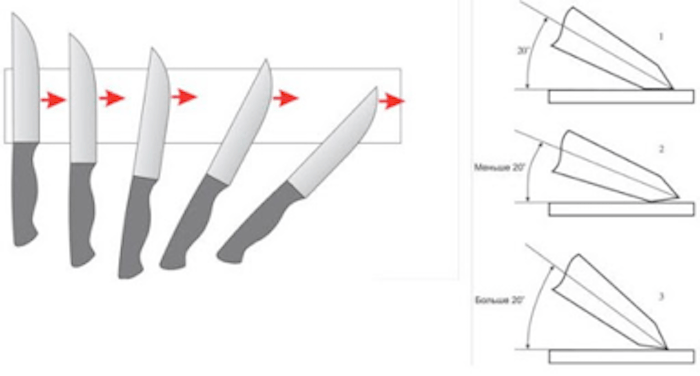
How to sharpen a kitchen knife? How to sharpen knives properly?
Content
The set of new knives impresses with its sharpness - they cut the thinnest paper without any problems. However, the blades become dull over time - then they can be replaced with new ones or, more economically and environmentally friendly, sharpened. How to safely sharpen knives at home - what to use and how?
How to sharpen knives professionally - what to use?
The easiest way to sharpen knives is to use a professional tool designed for this purpose, i.e. a special knife sharpener. What is important, this gadget can be in various modifications: diamond, universal and manual.
Diamond Knife Sharpener
An oblong accessory that visually resembles an elongated ice ax. A diamond knife sharpener is extremely easy to use and not only ensures that the blade cuts effortlessly, but also stays perfectly flat with no breaks or nicks. An exemplary product of this type is offered by the Richardson Sheffeld brand.
Universal knife sharpener.
A small kitchen gadget that can resemble a narrow U, with characteristic curved cutouts. Sharpening kitchen knives with a universal sharpener consists in moving the blade along the mentioned arcs. Depending on the model, there may be one or even four notches, as is the case with the Zwieger Visionary sharpener. Then each of them corresponds to a different degree of sharpening: the first level is a preliminary work that corrects the most dull and damaged knives, the second level straightens the knife and gives it a V-shape, and the third polishes it so that it shines and becomes sharp like razor. The last cut is used for sharpening serrated knives.
Manual knife sharpener
The cheapest of all sharpening equipment. A manual knife sharpener usually costs several tens of zlotys and consists of a small handle and a “file” extending from it, bent in an arc - the whole shape resembles the letter P or D. The work consists in moving the blade along the outside of a curved element, usually of tungsten carbide; this is the case, for example, in the case of the Victor sharpener from the Stalgast brand.
Correct sharpening of kitchen knives - sharpening angle of knives
The sharpening angle of your knives is just as important throughout the process as choosing the right sharpener. A job done poorly can be ineffective, no matter how good the equipment you use. At home, an angle of inclination from 20 to 25⁰ is well suited. Why at home"? Because the professional use of knives, for example by a Japanese chef demonstrating cutting, will require a more personal approach. Bone cutters are usually sharpened at an angle of about 40⁰, and very sharp kitchen knives require an angle of about 17⁰.
The most versatile angle is 25⁰, which is the answer to both how to sharpen a bread knife and how to sharpen hunting, sirloin, or carving knives. This is also what general purpose sharpeners usually offer.
How to sharpen knives in homemade ways - what items come in handy?
If you need a special way to sharpen knives, and a professional knife sharpener is just waiting to be picked up by a courier and delivered to your apartment, try one of the home methods. They are not a permanent solution, so it is worth having the right equipment, but in "critical" situations they prove to be really useful.
Warning about kitchen knives with cup or plate
The most popular is sharpening a knife on a ceramic cup or plate. The essence of the whole process is a flat rough circle at the bottom of the vessel. Usually, it is not covered with any varnish or paint by the manufacturer, so the coarser gradation of the material is visible to the naked eye, thanks to which the cup does not slip when placed on the table. The aforementioned gradation and the corresponding hardness of the ceramic make this circle a bit like the surface of a knife sharpener, and if necessary, it can imitate it.
In order to sharpen a knife with its help, the blades should be moved sideways (flat side) along this fragment of the vessel, from the end of the handle to the very tip. Change sides with each punch. In this case, the knife sharpening angle described above will also be important.
Using a stone ladder to sharpen knives
This method works in the same way as sharpening kitchen knives on ceramic utensils. However, in this case, you will be dealing with a stone. Stone stairs also usually have an unpolished thin strip with a rough gradation along the edge and are a very hard and durable material. Thanks to this, with their help, you can successfully sharpen a steel blade. The technique will be the same as in the case of a cup or plate - you should maintain the appropriate angle of the knife and move it evenly on both sides.
Sharpening kitchen knives on a stone window sill
If you don't have stone stairs at home, but you do have window sills made from this material, you can apply the tips above when using them. The whole process is identical, and the sharp edge of the window sill is used for sharpening. So you have to move the blade sideways along its edge, keeping the knife at the right angle and switching sides from time to time. However, do not attempt this on a metal, glass, or plastic window sill.
If you're looking for the best way to sharpen your set of knives and haven't ordered a new sharpener yet, be sure to check out our section for this inexpensive, useful piece of equipment.